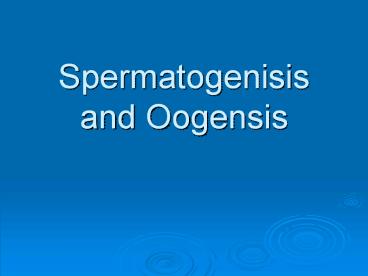Spermatogenisis and Oogensis - PowerPoint PPT Presentation
1 / 13
Title:
Spermatogenisis and Oogensis
Description:
Spermatogenisis and Oogensis Oogenesis Begins in the female embryo with production of oogonia from primordial germ cells Oogonia divide by mitosis to form primary ... – PowerPoint PPT presentation
Number of Views:100
Avg rating:3.0/5.0
Title: Spermatogenisis and Oogensis
1
Spermatogenisis and Oogensis
2
Oogenesis
- Begins in the female embryo with production of
oogonia from primordial germ cells - Oogonia divide by mitosis to form primary oocytes
- They are developmentally arrested cells (stopped
at prophase I before birth) - Reside in a small follicle
- At puberty, FSH periodically stimulates small
group of follicles to resume growth and
development
3
- Typically only one follicle fully matures each
month. - That primary oocyte completes meiosis I
- Second meiotic division begins, but stops at
metaphase - The secondary oocyte is arrested in meiosis II
until released at ovulation. - Only if a sperm cell penetrates the oocyte does
meiosis II resume
4
- Each of the meiotic division results in unequal
cytokinesis. - The smaller cells become polar bodies that
eventually degenerate (the first polar body may
or may not divide a second time) - The ruptured follicle left from ovulation becomes
the corpus luteum - If the released oocyte does not complete
oogenesis (fertilization), that corpus luteum
degenerates.
5
- FSH stimulates follicle development
- Estrogen produced by growing follicles (and
corpus luteum), high amounts signal ovulation - LH stimulates corpus luteum growth and
maintenance - Progesterone produced by corpus luteum.
Inhibits further ovulation, maintains uterine
lining during pregnancy
6
(No Transcript)
7
Spermatogenesis
- Initial germ cells of the embryonic testes
divide and differentiate into stem cells which
divide mitotically into spermatogonia - Spermatogonia generate spermatocytes (by mitosis)
- Each spermatocyte gives rise to 4
spermatids meiotic cell division to reduce
chromosome number from diploid (2n 46) to
haploid (n 23) - Spermatids differentiate into sperm
8
Spermatogenesis
- Stem cells situated near outter edge of
seminiferous tubules - As spermatogenesis proceeds, cells move steadily
inwards, as they pass through the stages - In the last step, the mature sperm are released
into the lumen of the tubule, which they travel
through to reach the epididymis.
9
(No Transcript)
10
Spermatogenesis
Sertoli Cells influence/nurture developing sperm
11
(No Transcript)
12
Video Representation
- Spermatogenesis
- http//highered.mcgraw-hill.com/sites/0072495855/s
tudent_view0/chapter28/animation__spermatogenesis_
_quiz_1_.html - Oogenesis
- http//highered.mcgraw-hill.com/sites/0072495855/s
tudent_view0/chapter28/animation__maturation_of_th
e_follicle_and_oocyte.html
13
Spermatogenesis vs. Oogenesis
Spermatogenesis Oogenesis
All 4 products of meiosis develop into mature gametes 1 mature gamete (ovum), 3 polar bodies that degenerate
Occurs throughout adolescence and adulthood Mitotic divisions complete before birth, and production of mature gametes ceases around age 50
Produces mature sperm from percursor cells in continuous sequence Had long interruptions during the development of mature gamete































